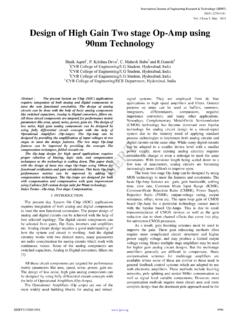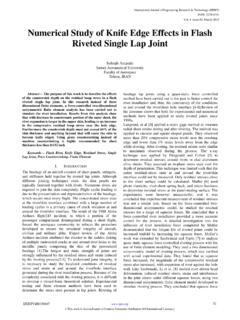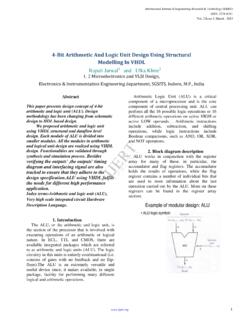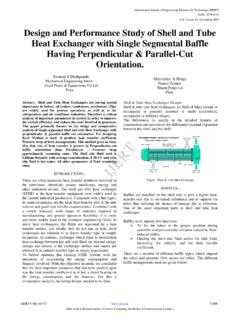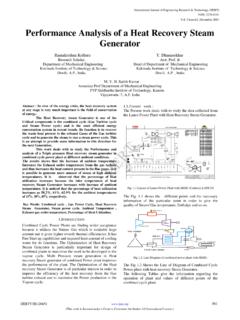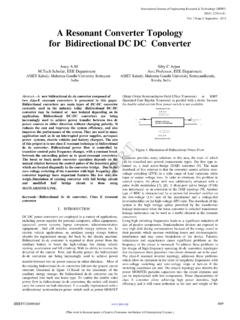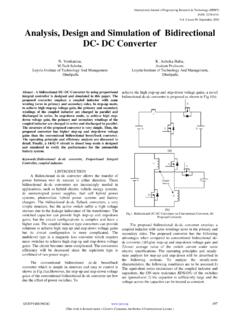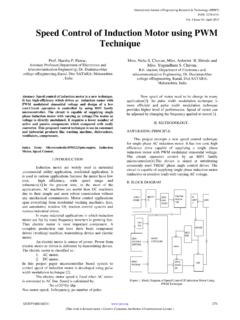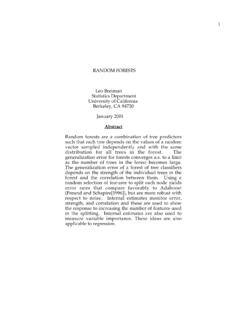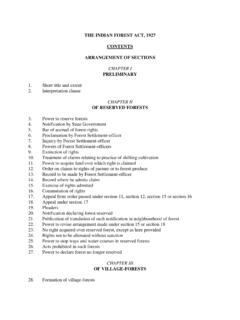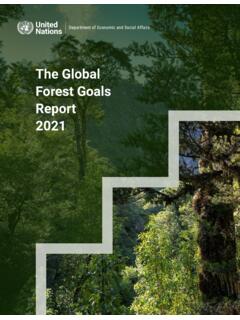Transcription of Environmental Impact of Paper Industry - IJERT
1 Environmental Impact of Paper Industry Review Paper on Part of Each Countryin this Impact M Suraj Mechanical Dept, , Bhilai Bhilai Nagar, Durg, India Akram Khan Mechanical Dept, , Bhilai Bhilai Nagar, Durg, India Abstract One of the most used component in our daily life is Paper . According to a survey, on an average, a human use 27kgs of Paper annually and this thesis is about Impact of usage of Paper on our environment. Historically pulp and Paper production has ranked among the most resource-intensive and highly polluting of all manufacturing industries. Besides fibre, the primary inputs into the Paper making process are water, energy and chemicals I. INTRODUCTION The production is Paper is a tough and lengthy process and the process is shown in the form of figure. 93% of raw material for the production of Paper comes from trees.
2 Of an average tree, we get 8000 white pages after production. IT Industry once predicted that its emergence is to make paperless offices but amazing finding is that still 95% of office work across the world is still done on Paper . To produce Paper takes twice the energy used to produce a plastic bag. Everything takes energy to produce. In the case of Paper , it also involves cutting down trees. Deforestation is one of the main Environmental problems we re facing in these times. 42% of all global wood harvest is used to make Paper . Is it really worth it to cut down our life saving trees for this product? The method of making Paper is essentially a simple one mix up vegetable fibers, and cooks them in hot water until the fibers are soft but not dissolved. The hot water also contains a base chemical such as lye, which softens the fibers as they are cooking.
3 Then, pass a screen-like material through the mixture, let the water drip off and/or evaporate, and then squeeze or blot out additional water. A layer of Paper is left behind. With the help of flow chart in figure 1, I have tried to showcase the journey of Paper from Trees to Tea Table to dustbin. II. EASE OF USE Environmental degrading components in production of Paper . Raw Materials Probably half of the fiber used for Paper today comes from wood that has been purposely harvested. The remaining material comes from wood fiber from sawmills, recycled newspaper, some vegetable matter, and recycled cloth. Coniferous trees, such as spruce and fir, used to be preferred for papermaking because the cellulose fibers in the pulp of these species are longer, therefore making for stronger Paper .
4 These trees are called "softwood" by the Paper Industry . Deciduous trees (leafy trees such as poplar and elm) are called "hardwood." Because of increasing demand for Paper , and improvements in pulp processing technology, almost any species of tree can now be harvested for Paper . Chemicals Figure 1 : Flow chart of Paper Industry from The papermaking Industry has also come under fire for its heavy use of chemicals like chlorine and chlorine compounds. Paper mills generally rely on a mix of toxic chemicals for reducing wood to pulp and bleaching Paper . Mercury, water effluents such as absorbable organic halides and total suspended solids, and solid waste such as boiler ash and effluent sludge are all potential byproducts from this Industry The chemicals used in Paper manufacture, including dyes, inks, bleach, and sizing, can also be harmful to the environment when they are released into water supplies and nearby land after use.
5 The Industry has, sometimes with government prompting, cleared up a large amount of pollution, and federal requirements now demand pollution free Paper production. The cost of such clean-up efforts is passed on to the consumer Energy Requirement Worldwide, the pulp and Paper Industry is the fifth largest consumer of energy, accounting for four percent of all the world's energy use. The pulp and Paper Industry uses more water to produce a ton of product than any other Industry . The pulp from trees itself is burnt to produce energy required for production of Paper . International Journal of Engineering Research & Technology ( IJERT )ISSN: 2278-0181 Published by, Conference ProceedingsVolume 3, Issue 20 Special Issue - 2015 III. DIRECT EFFECTS The requirement of raw material require cutting a lot of trees. A trees takes so many years to grow into wood required for production of Paper , for raw material, it take minutes for a tree to fell.
6 According to statistics against WHO criteria of each country having 33% of forest land, our country India have only of total land cover under forests. The bleaching reagents without proper treatment got released into river bodies proves to be graveyard for hydrological ecology. The evolution of chlorine and waste gases to atmosphere results in another form of pollution. IV. INDIRECT EFFECTS Deforestation causes to increase in CO2 levels. CO2 concentration over a period of 130 years. Courtesy: Conflicts between Local bodies. The requirement of raw material pressurise the requirement to get more and more raw material. This results in illegal deforestation of forest land, which the local villages used for millions of years as a source of energy. These forests met their daily needs ranging from food to fuel. Every day millions of trees are cut down unknowingly and many times conflicts arises to bloodshed.
7 One such incident occurs recently in the border area of Rajnandgaon and Maharashtra. Decrease of water table Water table, level of water in earth at a specific area. According a survey, about 300-400 tons of water is required to produce one ton of Paper . The water used in production of Paper cannot be recharged or cannot be used as a result of which level of water in land go on decreasing. The result is it is required to go more and deeper into the earth to get water now a days. This also leads to famine in many parts of country. One such example is of Andhra Pradesh Femine 2003, more than 120 people died of famine. Seasonal Changes One of the affect of direct effects of Paper Industry . Due to global deforestation, global warming occurs due to this, corollisis affect which takes place on earth changes.
8 The effect takes place between pressure belts present on earth between tropics and equator. Due to global warming, the belts disturbs and uneven climatic changes occur. One of the recent example is of Mumbai rainfall. Highly deflected from normal, last year Mumbai get more than thrice the rainfall in got in last 30 years. Figure 3: Flow dynamics of wind flow on earth IV. REVIEW OF RECENT TRENDS Recycling of used Paper Although recycling reduces use of raw material to some extent but it is very difficult to produce tree at a pace at which they are cut down every day. Even after recycling or use of water Paper to produce new Paper 93% of raw material should be required for making fresh and good quality Paper . Another this recycling was not everybody prefers. Let s say in India, ITC was the only company which recycles the used Paper till now.
9 Treatment of water It is very difficult to restore back polluted water back. Dechlorination process is a lengthy process and need Estimate usage of Paper in state college. Consideration: We consider an engineering college with five branches having a capacity of 400 seats. Following are the events which use Paper either directly or indirectly in a semester six months time. International Journal of Engineering Research & Technology ( IJERT )ISSN: 2278-0181 Published by, Conference ProceedingsVolume 3, Issue 20 Special Issue - 2015( ) TABLE 1. THE ASSUMED Paper USAGE OF AN ENGINEERING COLLEGE Event No of sheets used No of units Total no of sheets 1. Answer sheet 40/ copy 5 80,000 2 Question Paper Approx 2/ Paper 5 4000 3. Documentation sheets 50/semester 5 250 4. Practical files 100 pages/practical 3 1,20,000 5. Test copies 20 pages 5 40,000 6. Notes preparation 200 pages copy 5 400,000 7.
10 Registration & other forms 10pages/student 5 20,000 8. Departmental uses 1000pages/dept 5 5000 9. Project files 200 pages/file 1 80,000 Total : According to a survey, an average tree gets converted in to 12000 A4 sheets. As per our calculations, we require almost 300 trees to run a semester and a tree requires minimum 3 years to grow and become mature. V. CONCLUSION The results which we get from this research helps a lot in sustainable growth of Paper Industry along with help regarding conservation efforts for our delicate environment. VI. FUTURE SCOPE The study is first of its type and need evidence for better and accurate results. This Paper is published as review Paper and should require minds to convert these statistics into a mathematical model so as to form policies which are eco-friendly and to save our delicate environment.

